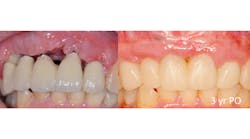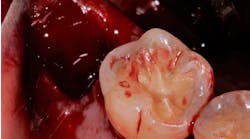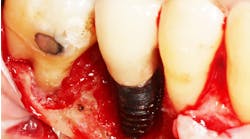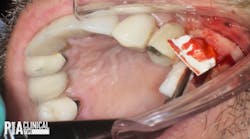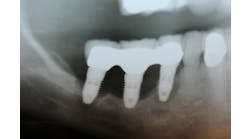Surgical solutions to implant soft-tissue deficiencies in the esthetic zone
Dr. Paul P. Lin offers a preview of his presentation for the upcoming Academy of Osseointegration's Annual Meeting in Los Angeles later this month on surgical solutions to correct soft-tissue deficiencies surrounding dental implants, focusing on implants placed too far buccally. He will also discuss surgical management for complications involving poor implant positioning and the presence of infection.
Soft-tissue deficiency is the main factor that causes poor esthetics around dental implants. It is primarily a volumetric inadequacy, which consists of concavity and recession of labial tissue and/or loss of interdental papilla. This deficiency can occur in three phases: prior to the second stage, during the provisional phase, and after permanent restoration. Surgical management in each of these phases can be very different, and complicated by poor implant positioning and the presence of infection.
The purpose of my presentation, “Solutions to Implant Soft-Tissue Deficiencies in the Esthetic Zone” on Saturday, March 3, 2018, as part of the Academy of Osseointegration’s (AO) 2018 Annual Meeting, will be to provide surgical solutions to correct soft-tissue deficiencies with the following three variables: timing (surgical exposure, provisional, and implant complications), type of tissue loss (midfacial and/or interdental), and status of the tissue around the implant (healthy or diseased). The majority of my presentation will focus on poor esthetics surrounding implant complications. Specific surgical consideration and techniques will also be presented for implants that are placed too far buccally.
The outline of my presentation will be laid out in the following five chapters:
I. Introduction: Indications, diagnosis, and treatment planning.
II. Surgical procedures utilized for second-stage exposure: APF, semilunar, Rolled technique, VIP-CT, CTG via crestal pouch.
III. Surgical procedures utilized during provisional phase: Rolled technique, CTG via lateral pouch or apical pouch.
IV. Surgical procedures utilized for implant complications: CTG via lateral pouch or apical pouch, VIP-CT, decontamination techniques, guided bone regeneration (GBR).
V. Concluding remarks: Graft survival principles, evidence-based but not limited.
Soft-tissue deficiency always comprises the loss of both soft and hard tissue. However, for predictability, the surgical solution may direct toward correction of the extrinsic gingival characteristics in particular size and contour utilizing soft-tissue graft only. When there is evidence of disease status with nonresolved probing depth, should one consider using both soft- and hard-tissue augmentation techniques to regenerate lost soft and hard tissues?
In summary, the degree of difficulty increases as the later appearance of poor esthetics, the demand for papillary improvement, and the presence of contaminated implant occurs. The selection of the surgical technique will be suggested from simplest to more advanced and from less effort to more efforts to accommodate the amount of lost soft tissue and the status of supra- and substructure. Techniques in terms of how to maximize the blood supply and minimize the scar will also be discussed. Decision-making charts and tables, illustrative graphs, and video clips of major surgical procedures and clinical cases with long-term results over three years will be utilized during my presentation to demonstrate that optimal esthetic and lasting results can be obtained.
Editor's note: Dental professionals can hear Dr. Lin’s full presentation on "Solutions to Implant Soft-Tissue Deficiencies in the Esthetic Zone" by attending the Academy of Osseointegration’s 2018 Annual Meeting, “Inspiring Imagination—Enhancing Health,” to be held February 28–March 3, 2018, at the Los Angeles Convention Center. For all meeting details, including online registration, please visit meetings.osseo.org/2018. Follow news about the meeting on social media using #AO18LA.
